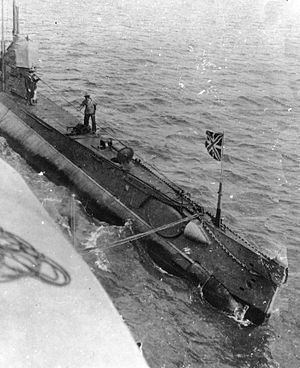Class and type American Holland class Completed 1916 Commissioned 21 July 1917 Test depth 50 m Beam 4.9 m | Name AG-13 Renamed AG-16 Length 46 m Draft 3.81 m | |
 | ||
Fate accidentally sunk, but raised Builder General Dynamics Electric Boat | ||
The Finnish submarine AG-16 was an AG-class submarine, designed by the American Holland Torpedo Boat Company/Electric Boat Company, built for the Imperial Russian Navy during World War I. The submarine was fabricated in Canada, shipped to Russia and reassembled for service with the Baltic Fleet. The boat was originally named AG-13, but was redesignated AG-16 after it sank and was repaired in 1917.
Contents
Description
AG-13 was a single-hulled submarine, with a pressure hull divided into five watertight compartments. The submarine had a length of 150 feet 3 inches (45.8 m) overall, a beam of 16 feet (4.9 m) and a draft of 12 feet 6 inches (3.8 m). She displaced 355 long tons (361 t) on the surface and 433 long tons (440 t) submerged. The AG-class submarines had a diving depth of 164 feet (50.0 m) and a crew of 30 officers and enlisted men.
The submarine had two 3-bladed propellers, each of which was driven by a 480-horsepower (360 kW) diesel engine as well as a 640-horsepower (477 kW) electric motors. This arrangement gave AG-22 a maximum speed of 13 knots (24 km/h; 15 mph) while surfaced and 10.5 knots (19.4 km/h; 12.1 mph) submerged. She had a range of 1,750 nmi (3,240 km; 2,010 mi) at 7 knots (13 km/h; 8.1 mph) while on the surface and 25 nmi (46 km; 29 mi) at 3 kn (5.6 km/h; 3.5 mph) while submerged. Her fuel capacity was 16.5 long tons (16.8 t) of fuel oil.
The AG-class submarines were equipped with four 18-inch (457 mm) torpedo tubes in the bow and carried eight torpedoes. For surface combat they had one 47-millimeter (1.9 in) deck gun.
Construction and service
The Holland 602 design was widely exported during World War I and the Imperial Russian Navy ordered a total of 17, in three batches, of a version known as the American Holland-class (AG in Russian for Amerikansky Golland (American Holland)). The submarines were to be built in Canada as knock-down kits for assembly in Russia.
Components for the first batch of five submarines were assembled in Barnet, near Vancouver, British Columbia, Canada, and shipped to Vladivostok. There they were loaded onto the Trans-Siberian Railroad and transported to Saint Petersburg where they were assembled by the Baltic Works by June 1916. AG-13 accidentally sank in 1917 and was redesignated AG-16 when salvaged and put back into service. During World War I Russian and British submarines operated from bases in Finland. The Russian submarines of Holland type (AG-11, AG-12, AG-15 and AG-16) were scuttled in the harbor of Hanko on 3 April 1918 just prior to the German landing there. AG-12 and AG-16 seemed to be in relatively good shape and the Finns decided to salvage them. AG-16 was transferred to Helsinki and the Finns asked both Germany and Electric Boat for estimates on the cost of repairs. The latter was so costly so only the German alternative remained. German experts evaluated AG-16, but the Finnish government never provided funds for the repairing of the submarine. The repairs would be costly and no shipyard were prepared to guarantee the results. The submarine was stored on dry land until 1929 when the Finnish government finally agreed on the new Fleet program, which also included new submarines. AG-16 was then scrapped.
